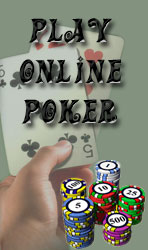Pokerwiner.com → Lessons of poker
Now suppose instead of a perfect eight-low, you have the following hand:





You
Once again you’re up against that player who never bluffs but worries that everyone else does. You’re first. How should you play?
Here you should check and fold if your opponent bets. Since your hand beats only queen, and ten-lows (the losing hands with which your opponent would call), it is no longer worth a bet for value, because you get beat with his
nine-lows and better.
And since this opponent never bets on a bluff, you should fold in the face of a bet. The odds that you are beat are overwhelming.
First Position Play in Terms of the Strength of Your Hand
We’ll wrap up play in first position by summarizing it according to the strength of your hand. If your hand is a cinch or a near cinch, you have two options.
One is to bet, and one is to check-raise. You would decide which to do according to the check-raise formula presented earlier.
However, if you are sure you have the best hand but suspect your opponent will raise if you bet, you should bet out in an attempt to win three bets when your opponent raises and you reraise.
If your hand figures to be a favorite when called but is not good enough to check-raise, you have two options – to bet or to check and then call.
Basically you bet if your opponent will call with more hands than he’ll bet with and you check and call if he’ll bet with more hands than he’ll call with.
If you hand is an underdog when called, you have three options. One is to bet, a second is to check and call, and the third is to check and fold. (A bluff check-raise is a remote possibility against very tough players who are capable of very tough folds.)
You should check and call if your opponent will bet more hands than he will call with, including some hands you can beat.
You should also check and call when your opponent will check many hands that will beat you but might come out bluffing with some hands you can beat.
And you should come out betting if you have a calling hand but your opponent will call with more hands than he will bet.
Summary
The concepts in this long chapter are important and slippery enough to warrant a final framing in an outline summary. The essence of each play is a judgment of its expectation.
Ι. Last Position play
1. Call if your hand is not worth a raise but has a better chance of winning than the pot odds you are getting. Your chances of winning are the sum of the chances that your opponent is bluffing, plus the chances that your hand can beast his legitimate hand.
2. Raise if your opponent will still be the underdog after calling your raise. Raise also as a bluff if you think it will work often enough to have positive expectation. Also consider raising with what appears to be a calling hand if your opponent is capable of throwing away a better hand than yours for one more bet.
B. If you are second to act when all the cards are out and your opponent checks:
1. Bluff if you think it will work often enough, remembering that a bluff does not tend to work as often in second position as it might in first position.
2. Bet your hand for value if you are a favorite to have the best poker hand, even when your opponent calls your bet. Don’t bet in close situations to avoid a check-raise.
∏. First Position Play
A. If you are first to act when all the cards are out and have a very strong hand:
1. Try to check-raise if your opponent will bet and call your raise more than half as often as he will call you when you bet.
2. Come out betting if you don’t think a check-raise will work often enough to be profitable or if you think you can win three bets when your opponent raises and you reraise.
Finally, if you have virtually no chance of winning if you check an your opponent bets and you are an underdog if you bet and he calls, then the proper play is to check and fold if he bets.
B. If you are first to act and have a bad hand:
1. Bluff if you can get away with it often enough for the play to have positive expectation.
2. Otherwise check and fold if your opponent bets.
C. If you are first to act have a hand that is a favorite to win if called but not strong enough for you to try
a check-raise:
1. Bet if your opponent will call with more hands than he will bet with if you check.
2. Check and call if your opponent will bet with more hands than he will call with.
3. Never check and fold.
D. If you are first to act and have a hand that is a small underdog to win when you bet is called:
1. Bet if you opponent will call with more hands than he will bet, as long as some of the hands he would have bet, had you checked, would be worse than yours. Check and call if you think your opponent will check behind you with a significant number of hands better than yours but might still with some hands you can beat.
2. Check and call if your opponent will bet with more hands than he will call with, as long as your as your pot odds make it worth calling when he does bet.
3. Check and fold if your opponent will almost never bet a hand worse than yours.



